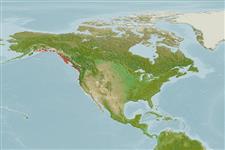Polyplacophora |
Chitonida |
Mopaliidae
Environment: milieu / climate zone / depth range / distribution range
Ecology
Benthic; depth range 0 - 18 m (Ref. 290). Temperate
Eastern Pacific: Alaska and USA.
Length at first maturity / Size / Weight / Age
Maturity: Lm ? range ? - ? cm Max length : 5.1 cm TL male/unsexed; (Ref. 296)
Valve colors: Rose, violet, light blue, green, yellow, reddish brown, orange or any combination of these. Girdle: Moderate width and is yellowish to light brown in color. Girdle: Has minute spicules interspersed with larger pointed spicules singly or in groups; there are also random coarse bristles bearing many spicules (Ref. 296).
Depth based on occurrence record; to be replaced with better reference. Usually found on the bottom of large rocks (Ref. 290).
Life cycle and mating behavior
Maturity | Reproduction | Spawning | Eggs | Fecundity | Larvae
Members of the class Polyplacophora are mostly gonochoric. Life cycle: Eggs hatch into lecitotrophic planktonic trocophore larvae (no veliger stage) which later metamorphose and settle on the bottom as young adults.
Burghardt, G. and L. Burghardt. 2006. (Ref. 296)
IUCN Red List Status (Ref. 130435)
CITES status (Ref. 108899)
Not Evaluated
Not Evaluated
Threat to humans
Human uses
| FishSource |
Tools
More information
Age/SizeGrowthLength-weightLength-lengthMorphologyLarvaeAbundance
Internet sources
Estimates based on models
Preferred temperature
(Ref.
115969): 7.1 - 14, mean 9.6 (based on 170 cells).
Vulnerability
Low vulnerability (10 of 100).
Price category
Unknown.
